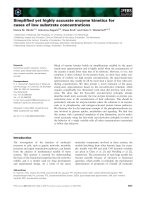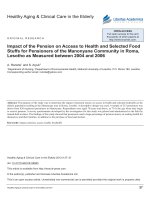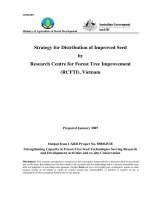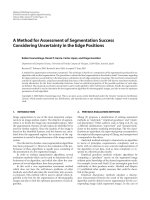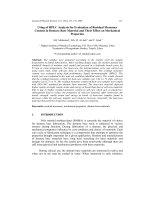Promotional strategy for Queencare of Global Nutri Co
Bạn đang xem bản rút gọn của tài liệu. Xem và tải ngay bản đầy đủ của tài liệu tại đây (2.13 MB, 87 trang )
!
!
!
!
ACKNOWLEDGEMENT OF COMMITMENT
I attest that this final project for the Vietnam-Belgium MBA program studying
the case of Queencare product, a functional food product of Global Nutri Co., is
my original work.
All data and information in this project are true and collected from sources of
the company, customer survey and other official sources.
Nguyen Thi Khanh Giang
!
!
!
!
ACKNOWLEDGE
Firstly, I would like to express my sincere thanks to my supervisor Dr. Nguyen
Van Ngai, who has supported, guided and encouraged me a great deal to
complete this final project.
Secondly, I am enormously grateful for - Mr. Pham Thanh Nghi who has
sponsored me to attend this MBA program, and I’d like to say thanks to all of
my family, colleagues, and friends who have always assisted me during this
program.
Finally, I highly appreciate the Vietnam - Belgium MBA program, as well as
board of coordinators of this program who contributes greatly to my learning
progress.
!
!
!
!
TUTOR’S COMMENTS
I am writing to confirm that the project named PROMOTIONAL STRATEGY
FOR QUEENCARE OF GLOBAL NUTRI CO, written by Nguyen Thi Khanh
Giang, has valued in reality and satisfied the requirement of the Master project
for MBA Program.
I agree the candidate Nguyen Thi Khanh Giang to present the project in the
defense jury.
March, 1
st
2011
Tutor
Dr. Nguyen Van Ngai
∀!
!
!
!
ABSTRACT
This final project proposes building an effective promotional strategy for
Queencare product, a kind of functional food of Global Nutri Co. through
promotional tools and customer’s interest.
In the context of the very promising market and the development potential of
functional foods, a new product like Queencare and its message need to be
informative and delivered to customer broadly. It is the reason why the writer has
implemented this study.
In this study, the writer provides an overview of Vietnamese economics,
functional foods and customer perception about functional foods which have been
present in Vietnam since 2000.
In addition, the study also reviews the current marketing program of Global Nutri
Co. in general and promotional program in particular through customer surveys in
order to build a new promotional strategy for Queencare.
∀!
!
!
!
TABLE OF CONTENTS
CHAPTER 1 – INTRODUCTION ………………………………………………………………………………………………. 1
1.1 Problem Statement …………………………………………………………………………………………………………………………… 1
1.2 Research Objectives and Research Questions………………………………………………………………………… 2
1.2.1 Research Objectives…………………………………………………………………………………………………………………… 2
1.2.2 Research Questions…………………………………………………………………………………………………………………… 2
1.3 Scope and Limitations……………………………………………………………………………………………………………………… 2
1.3.1 Scope of Study……………………………………………………………………………………………………………………………… 2
1.3.2 Limitations of Study…………………………………………………………………………………………………………………… 3
1.4 Study Methodology and Data Source………………………………………………………………………………………… 3
1.4.1 Methodology………………………………………………………………………………………………………………………………… 3
1.4.2 Data Sources………………………………………………………………………………………………………………………………… 4
1.5 Structure of Study……………………………………………………………………………………………………………………………… 4
CHAPTER 2 - THEORETICAL FRAMEWORK ………………………………… …………………………. 6
2.1 Marketing Concepts…………………………………………………………………………………………………………………………… 6
2.2 Marketing Mix……………………………………………………………………………………………………………………………………… 6
2.3 Theory of Integrated Marketing Communication ………………………………………………………………… 7
2.4 Promotional Strategy………………………………………………………………………………………………………………………… 8
2.4.1 Definitions………………………………………………………………………………………………………………………………………… 8
2.4.2 Push versus Pull Strategy …………………………………………………………………………………………………………… 8
2.5 Promotion Mix……………………………………………………………………………………………………………………………………… 9
2.5.1 Advertising ……………………………………………………………………………………………………………………………………… 10
2.5.1.1 Advantages
and disadvantages of advertising ………………………………………………………………… 11
2.5.1.2
Types of advertising ………………………………………………………………………………………………………………… 11
∀ !
!
!
!
2.5.2 Direct Marketing …………………………………………………………………………………………………………………………… 13
2.5.2.1 Advantages and Disadvantages of Direct Marketing ………………………………………………… 13
2.5.2.2 Channels of Direct Marketing ……………………………………………………………………………………………… 14
2.5.3 Interactive / Internet Marketing ……………………………………………………………………………………………… 15
2.5.3.1 Advantages and Disadvantages of Internet and Interactive ……………………………………… 16
2.5.2.2 Combination of Internet and other promotion tools ……………………………………………………… 17
2.5.4 Sales Promotion……………………………………………………………………………………………………………………………… 18
2.5.4.1 Advantages and Disadvantages of Sales Promotion …………………………………………………… 19
2.5.4.2 Customer-oriented promotions ……………………………………………………………………………………………… 19
2.5.5 Publicity / Public Relations ………………………………………………………………………………………………………… 24
2.5.5.1 Public Relations …………………………………………………………………………………………………………………………… 24
2.5.5.2 Publicity ………………………………………………………………………………………………………………………………………… 25
2.5.6 Personal Selling ……………………………………………………………………………………………………………………………… 25
2.5.6.1 Advantages of personal selling ……………………………………………………………………………………………… 25
2.5.6.2 Disadvantages of personal selling ……………………………………………………………………………………… 26
2.6 Process of building promotional strategy ………………………………………………………………………………… 27
CHAPTER 3 -
INTRODUCTION TO FUNCTIONAL FOOD AND QUEENCARE 28
3.1 Introduction to Functional Food……………………………………………………………………………………………………. 28
3.1.1 Terminology and Definitions……………………………………………………………………………………………………… 28
3.1.2 Role of Functional Foods……………………………………………………………………………………………………………… 30
3.1.3 Industry Analysis …………………………………………………………………………………………………………………………… 30
3.1.4 Customer Perception about Functional Food ……………………………………………………………………… 32
3.1.5 Description of the Global Nutri Co ………………………………………………………………………………………… 34
3.1.6 Introduction to Queencare Product ………………………………………………………………………………………… 34
3.1.7 Overview of Vietnamese Economy………………………………………………………………………………………… 35
∀ !
!
!
!
CHAPTER 4 - CURRENT PROMOTIONAL PROGRAM …………………………………………… 37
4.1 Introduction………………………………………………………………………………………………………………………………………… 37
4.2 Review of Marketing Plan …………………………………………………………………………………………………………… 37
4.3 Current Promotional Program ……………………………………………………………………………………………………… 41
4.4 Strengths and Weaknesses of Current Promotion ………………………………………………………………… 45
4.5 Conclusions …………………………………………………………………………………………………………………………………………… 46
CHAPTER 5 - PROMOTIONAL STRATEGY FOR QUEENCARE PRODUCT… 47
5.1 Promotional Strategy ………………………………………………………………………………………………………………………… 47
5.1.1 Advertising Strategy……………………………………………………………………………………………………………………… 47
5.1.2 Direct Marketing Strategy…………………………………………………………………………………………………………… 51
5.1.3 Interactive/Internet Marketing Strategy………………………………………………………………………………… 52
5.1.4 Sales Promotion Strategy……………………………………………………………………………………………………………… 54
5.1.5 Publicity/Public Relations Strategy………………………………………………………………………………………… 55
5.1.6 Personal Selling Strategy……………………………………………………………………………………………………………… 57
5.2 Determine Promotion Budget ……………………………………………………………………………………………………… 57
CHAPTER 6 - CONCLUSIONS AND RECOMMENDATIONS …………………………………… 59
References …………………………………………………………………………………………………………………………………………………… 61
Appendix 1 ………………………………………………………………………………………………………………………………………………… 62
Appendix 2 ………………………………………………………………………………………………………………………………………………… 64
Appendix 3 ………………………………………………………………………………………………………………………………………………… 69
Appendix 4 ………………………………………………………………………………………………………………………………………………… 71
Appendix 5 ………………………………………………………………………………………………………………………………………………… 76
Appendix 6…………………………………………………………………………………………………………………………………………………… 76
Appendix 7…………………………………………………………………………………………………………………………………………………… 77
∀ !
!
!
!
LIST OF ABBREVIATIONS
BMI : Business Monitor International
FAO : Food and Agriculture Organization
GSO : General Statistics Office
SRI : SRI international, an independent, nonprofit research institute
GDP : Gross Domestic Product
TV : Television
TVC : Television commercial
Ad/Ads : Advertising
FF : Functional food
PR : Public Relation
IWS : Internet World Stats
P.O.S.M : Point of Sale Materials
#!
!
!
!
LIST OF FIGURES
Figure 2.1: Push strategy
Figure 2.2: Pull strategy
Figure 2.3: Elements of promotional mix
Figure 2.4: Sales promotion
Figure 2.5: Types of consumer promotions use by packaged-goods manufacturers
Figure 2.6: Consumer-oriented sales promotion tools for various marketing objectives
Figure 3.1: Product benefit between Functional food and Drug
Figure 3.2: Players in Functional food market
Figure 3.3: Customer evaluation about price of functional food
Figure 3.4: Customer evaluation of different characteristics of functional food
Figure 4.1: Product life-cycle of Queencare
Figure 4.2: Queencare sale volume
Figure 4.3: Brand awareness
Figure 4.4: Channels bringing customer to use Queencare
Figure 4.5: Percentage of user evaluation toward Queencare TVC
Figure 5.1: Changes in use of Vietnamese media
Figure 5.2: Media chosen for entertainment/information
Figure 5.3: Queencare advertising strategy
Figure 5.4: Asia top ten internet countries
Figure 5.5: Purpose to be online
Figure 5.6: Target customer’s interest toward sales promotion program
Figure 5.7: Interest of Queencare users toward sales promotion program
Figure 5.8: Exhibition which target customer attended
Figure 5.9: Evaluation of customer about health seminars
#!
!
!
!
LIST OF PICTURES AND TABLES
PICTURES
Picture 3.1: Queencare product
Picture 4.1: Interface of Queencare product on company website
Picture 4.2: Pictures of other implemented advertisements of Queencare
TABLES
Table 3.1: GDP of Vietnam over years
Table 3.2: Healthcare expenditure per capita in Vietnam
Table 4.1: Queencare specification and price over periods
Table 4.2: Vietnam population
Table 4.3: Queencare and competitive products
Table 4.4: Cost of Promotion program in 2010
Table 5.1: Promotion budget
!
!
!
!
CHAPTER 1
INTRODUCTION
1.1 Problem Statement
Healthcare products for women are having a potential market in Vietnam; especially products
that help solve sexual problems and gynecological diseases. First of all, over 50.6% of
Vietnamese populations are women. Moreover, there are very few products on the market
that do not require a prescription to purchase one while Vietnamese women are very shy to
go to a doctor to discuss about their problems. Understanding that sensitivity of women and
recognizing the potential winning opportunity of the product itself, Global Nutri Co has
researched and developed Queencare which is a functional food that helps prevent and
support to treat some gynecological diseases and the decline in sex life that women may have
to experience.
Queencare has been launched into market in 2008 to meet market demand. Even though,
with its acceptable price and quality along with nationwide distribution and a large potential
market, Queencare did not successfully create a market place for themselves at that time.
The sales volume of the product performed poorly. The reason for this being was because
target customers were not promptly informed and introduced to the product in a right manner.
Hence, the core problem is to come up with a way to effectively deliver Queencare messages
to target customers, convince them to buy the product and position the product.
There are four Ps of marketing mix: Product, Price, Place, and Promotion. Queencare is doing
quite well with the other three except for the forth P-Promotion which is one of the significant
factors in determining the success of any products by promoting the product to potential
customers as well as convincing them to buy the product.
Thus, this study will present an effective promotional strategy to support and coordinate
Queencare’s existing general marketing activities to ultimately increase its quantity of sales.
∀!
!
!
!
1.2 Research Objectives and Research Questions
1.2.1 Research Objectives
The main purpose of this research is to build an effective promotional strategy for Queencare
through promotion mix to deliver the Queencare product’s message to broad end customers and
encourage them to buy Queencare in order to boost sales volume. With this core purpose, the
study is to keep Queencare within the company’s overall objectives and develop a system to
assist the performance of the product. The research objectives are:
- To identify the current promotional program of the company.
- To identify the perceptions of two groups of customers: (1) one group is current
customers who have used Queencare, (2) and second group is target customers who
have not been determined that they use or have not used Queencare and understand
their preferences.
- To develop a new promotional strategy for Queencare.
1.2.2 Research Questions
In order to build an effective promotional strategy for Queencare product, the proposed
research intends to answer these questions:
Q1: What are preferences and expectations of target customer towards promotion
program?
Q2: What are current customers’ perceptions about Queencare?
Q3: How effective is the current promotion program for Queencare?
Q4: Which promotional strategy is suitable for Queencare?
1.3 Scope and Limitations
1.3.1 Scope of Study
The research study of Queencare case only focuses on Vietnam market, in term of promotion
(the fourth P of marketing mix) to analysis target customer’s interest and use 6 tools of
#!
!
!
!
promotional mix to create a promotional strategy to promote Queencare. That strategy will be
shown in the chapter 5 of this study.
Although Queencare is distributed nationwide now, the primary data collection is
implemented only in Ho Chi Minh City where it was launched first due to limited time and
budget. Thus, it is difficult to get an overall picture of the perception and interest of
consumers throughout the country towards the Queencare products when the customer survey
is only conducted in Ho Chi Minh City.
There are a lot of competitive products with the same uses like Queencare, including
medicines and functional foods. However, this study focuses only on products without
prescription (functional food): Queencare, Spacaps, Phytosoya, Herbalgra for Women and
Thien Dia Phuc To.
1.3.2 Limitations of Study
Due to the limitation of time and budget, the study only includes studying of consumer -
oriented promotion in sales promotion.
1.4 Study Methodology and Data Sources
1.4.1 Methodology
The research is done through two methods: desk research and quantitative research.
Desk research (secondary data)
Data from external: Data about industry, market size and competitive products.
Data from internal: information related to product, sales volume.
Quantitative research (primary data)
In this stage, the research combines survey and interview method.
- The survey method is implemented online with sample size of 100 women from age 30-50
to collect information about (a) interest of target customers, (b) their expectations about
health products (c) their favorite products. The survey is implemented by Google docs. An
email which attaches a link of questionnaire will be sent to writer’s friends and spread to their
∃!
!
!
!
friend network. First, the survey questionnaire was sent to 15 friends of writer to pilot survey.
After that, the questionnaire was modified and used to survey.
- Interview method is implemented by phone, with the data of interviewees collected at
pharmacies in Ho Chi Minh City and collected during consulting for customers when they
called to the company for consultancy. The interviewees consist of 40 women who used
Queencare. Collected information includes (a) customers’ perceptions about Queencare (b)
current position of Queencare in consumers’ mind.
Sample Method
The sample method used for this project is simple random sampling design in which every
element in the population has a known and equal chance of being selected as a subject.
1.4.2 Data sources
Secondary: available information collected from the company, Vietnam Food
Administration, Worldbank and from other agencies, offices and internet websites.
Primary: information collected through survey and interview method.
1.5 Structure of Study
Chapter 1 - Introduction - This chapter includes introductory information of the study,
including problem statement, objectives, scope and limitations, methodology and structure of
the study.
Chapter 2 - Theoretical Framework - This chapter provides theories related to promotion. It
includes some definitions of marketing, promotion, promotional strategy and reviewing of
marketing mix, integrated marketing communications.
Chapter 3 -
Introduction to Functional Food and Queencare - This chapter provides the
current situation of marketing and promotional program of Global Nutri Co with data collecting
from a survey and interviews.
%!
!
!
!
Chapter 4 - Current Promotional Program - this chapter provides the situation of current
promotional program of Queencare. It also mentions about customers’ interest toward
promotion.
Chapter 5 - Promotional Strategy - This chapter presents new promotional strategy for
Queencare product based on promotion tools like advertising, direct marketing, internet, sales
promotion, public relations and personal selling. The chapter also determines budget for
promotional strategy.
Chapter 6 - Conclusions and Recommendations - This chapter provides conclusions and
recommendations of the study.
&!
!
!
!
CHAPTER 2
THEORETICAL FRAMEWORK
2.1 Marketing Concepts
Marketing is a social process by which individuals and groups obtain what they need and
want through creating and exchanging products and values with others. (Philip Kotler)
Marketing is the analysis, planning, implementation, and control of carefully formulated
programs designed to bring about voluntary exchanges of values with target markets for the
purpose of achieving organizational objectives. It relies heavily on designing the
organization’s offering in terms of the target markets’ needs and desires, and on using
effective pricing, communication and distribution to inform, motivate, and service the
markets. (Philip Kotler)
The American Marketing Association (AMA), which represents marketing professionals in
the United States and Canada, defines marketing as the process of planning and executing the
conception, pricing, promotion, and distribution of ideas, goods, and services to create
exchange that satisfy individual and organizational objectives.
2.2
Marketing Mix
According to Philip Kotler, marketing mix is one of the dominant ideas in modern marketing.
We define marketing mix as the set of controllable tactical marketing tools that the firm
blends to produce the response it wants in the target market. The marketing mix consists of
everything the firm can do to influence the demand for its product. The many possibilities
gather into four groups of variables known as the 'four Ps'; product, price, place and
promotion.
Product means the totality of goods and services that the company offers the target market.
That is anything that can be offered to a market for attention, acquisition, use or consumption
∋!
!
!
!
that might satisfy a -want or need. It includes physical objects, services, persons, places,
organizations and ideas.
Price is what customers pay to get the product. The amount of money charged for a product
or service, or the sum of the values that consumers exchange for the benefits of having or
using the product or service.
Place includes the company’s activities that make the product available to target consumers.
Place refers to how products and services are delivered to customers for final usage or
consumption can make a difference regarding how customers perceive the quality and value
of the overall offering. Speed of delivery, guaranteed supply and availability, convenience to
shoppers and so forth can enhance buyer-seller relationships and increase customer
satisfaction. Consequently, firms are increasingly paying greater attention to how they
manage their distribution channels to deliver goods and services that customers want at the
right time, right place and right price.
Promotion means activities that communicate the product or service and its merits to target
customer and persuade them to buy.
2.3 Theory of Integrated Marketing Communication
The American Association of Advertising Agencies (the “4As”) which developed one of the
first definitions of integrated marketing communications, defies it as a concept of marketing
communications planning that recognizes the added value of a comprehensive plan that
evaluates the strategic roles of a variety of communication disciplines-for example, general
advertising, direct response, sales promotion, and public relations, and combines these
disciplines to provide clarity, consistency, and maximum communications impact.
The 4As’ definition focuses on the process of using all forms of promotion tool to achieve
maximum communication impact
Consumers’ perceptions of a company and/or its various brands are a synthesis of the bundle
of messages they receive or contacts they have, such as media advertisements, price,
(!
!
!
!
package design, direct-marketing efforts, publicity, sales promotions, websites, point-of-
purchase displays, and even the type of store where a product or service is sold.
The integrated marketing communications approach seeks to have all of a company’
marketing and promotional activities project a consistent, unified image to the marketplace. It
calls for a centralized messaging function so that everything a company says and does
communicates a common theme and positioning.
2.4 Promotional Strategy
2.4.1 Definitions
According to Johnson and Scholes (Exploring Corporate Strategy), strategy is defined as
followed:
Strategy is the direction and scope of an organization over the long-term, which gain
advantages for the organization through its configuration of resources within a challenging
environment, to meet the needs of the markets and to fulfill stakeholder expectations.
Promotional Strategy is a part of the marketing strategy as well as the organization’s
general strategy. It can be defined is the element of a firm's decision-making concerned with
choosing target and formulating the most appropriate promotion mix to influence it.
(businessdictionary.com)
2.4.2 Push versus Pull Strategy
Marketing theory distinguishes between two main kinds of promotional strategy: push and
pull strategy and the promotional mix is influenced by whether the company chooses a push
or pull strategy.
Push Promotional Strategy which programs designed to persuade the trade to stock,
merchandise, and promote a manufacturer’s products. The goal of this strategy is to push the
product through the channels of distribution by aggressively selling and promoting the item to
the resellers, or trade.
)!
!
!
!
Figure 2.1: Push strategy
Source: Philip Kotler – Principles of Marketing, page778
Pull Promotional Strategy which is spending money on advertising and sales promotion
efforts directed toward the ultimate consumer. The goal of a pull strategy is to create demand
among consumers and encourage them to request the product from the retailer. Seeing the
consumer demand, retailers will order the product from wholesalers (if they are used), which
in turn will request it from the manufacturer. Thus, stimulating demand at the end-user level
pulls the product through the channels of distribution.
Figure 2.2: Pull strategy
Source: Philip Kotler – Principles of Marketing, page778
The selection push or pull strategy depends on types of products, markets and product life-
cycle stage. For some product, a combination of two strategies is selected.
2.5 Promotional Mix
Promotion has been defined as the coordination of all seller initiated efforts to set up
channels of information and persuasion in order to sell goods and services or promote an
idea. While implicit communication occurs through the various elements of the marketing
mix, most of an organization’s communications with the marketplace take place as part of a
∗+,−./0+
!!
1023450+6!37−!
89,506350+6!
:,76.;0+6!
∗+,−./0+!;3+<0247=!
3/24>42406!?≅0+6,735!605547=Α!
63506!≅+,;,24,7Α!,290+Β!
1060550+!;3+<0247=!3/24>42406!
?≅0+6,735!605547=Α!3−>0+24647=Α!
63506!≅+,;,24,7Α!,290+Β!
∗+,−./0+
!!
1023450+6!37−!
89,506350+6!
:,76.;0+6!
∗+,−./0+!;3+<0247=!3/24>42406!?/,76.;0+!3−>0+24647=Α!63506!
≅+,;,24,7Α!,290+Β!
Χ0;37−
!
Χ0;37−
!
∆!
!
!
!
carefully planned and controlled promotional program. The basic tools used to accomplish an
organization’s communication objectives are often referred to as the promotional mix.
Figure 2.3: Elements of promotional mix
Promotional mix
Source: George E.Belch & Michael A. Belch, 2003
The wide range of marketing and promotional tools must be coordinated to communicate
effectively and present a consistent image to target markets.
2.5.1 Advertising
Advertising is defined as any paid form of non-personal communication about an
organization, product, service, or idea by an identified sponsor.
Advertising is the best-known and most widely discussed form of promotion, probably
because of its pervasiveness.
An effective advertising should be:
• Creative: it delivers the advertising message in a fresh, new way.
• Hard-hitting: its headline, copy, or graphic element stops readers or listeners dead in
their tracks.
• Memorable: it ensures that the audience will remember your business when they think
about the products and services you’re selling.
• Clear: it presents its message in a concise, uncomplicated, easy-to-grasp manner.
• Informative: it enlightens the audience about your business and products, while giving
them important reasons to buy from you.
• Distinctive: it is unique and immediately recognizable as yours.
Ε−>0+24647=!
Χ4+0/2!
;3+<0247=!
Φ720+3/24>0Γ!
Φ720+702!
;3+<0247=!
Η3506!
≅+,;,24,7!
∗.Ι54/42ϑΓ!
∗.Ι54/!105324,7!
∗0+6,735!
605547=!
!
!
!
!
2.5.1.1 Advantages and Disadvantages of Advertising
Advertising is more and more popular and has some advantages as follow:
It can be a very cost-effective method for communicating with a large audience.
Advertising can be used to create brand images and symbolic appeals for a company or a
brand, a very important capability for companies selling products and services that are
difficult to differentiate on functional attributes.
One other advantage of advertising is its ability to strike a responsive chord with consumers
when differentiation across other elements of the marketing mix is difficult to achieve.
Popular advertising campaigns attract consumers’ attention and can help generate sales.
However, besides advantages, advertising also has some disadvantages. They will be
mentioned in each type of advertising.
2.5.1.2 Types of Advertising
There are many types of advertising, based on characteristic of products or services and
advertising goal, advertiser will choose one or combine many kinds of advertising as follows:
a) Online advertising: m
ost companies, even small businesses, have found this format to
be an inexpensive way to make their presence known to potential customers. It includes
advertising by building own websites or advertising on other companies’ websites in a variety
of ways that match advertisers’ needs and budget.
b) Advertising in prints: describes advertising in a printed medium such as newspapers
or magazines.
Newspapers are one of the traditional media used by businesses, both big and small
alike, to advertise their businesses. Because of a traditional medium, newspapers have many
advantages, such as high coverage, low cost, short lead time for placing ads, ads placed in
interest sections, timely (current ads). Furthermore, the reader control exposure and it can be
used for coupons. However, newspapers advertisement also has some disadvantage, such as
∀!
!
!
!
short life of ads, clutter, low attention-getting capabilities, poor reproduction quality and
selective reader exposure.
On the other hand, magazines have some advantages: segmentation potential, quality
reproduction, high information content, longevity of ads and multiple readers. However,
sometimes magazines are not effect because of long lead time for ad placement, visual only
and lack of flexibility.
c) Television advertising is the most popular and effective in recent time. Advertising on
television brings many effects because it has m
ass coverage, high reach, impact of sight,
sound, and motion and high prestige. It is attention getting with low cost per exposure and
favorable image. However it brings some disadvantages as well because it has low selectivity
and tends to be clutter. In addition, its message life is short and production costs, as well as
absolute cost are high.
d) Radio advertising. For this kind of advertising, it is effective because of local
coverage, low cost with high frequency, flexible and well-segmented audiences. However,
like other kinds of advertising, radio advertising has some disadvantages because it is audio
only, clutter, low attention getting and fleeting.
e) Billboard advertising (outdoor advertising)
This tool of advertising, it brings some advantages, such as location specificity, high
repetition and easy notice. Disadvantages of billboard advertising are short exposure time
being short, poor image of brand and product and location restrictions.
f) In store advertising: is any advertisement placed in a retail store. It includes
placement of a product in visible locations in a store, such as at eye level, at the ends of aisles
and near checkout counters, eye-catching displays promoting a specific product, and ads in
such places as shopping carts and in-store video displays.
#!
!
!
!
2.5.2 Direct Marketing
Direct marketing is a promotional tool with which organizations communicate directly with
target customers to generate a response and/or a transaction. This response may take place in
the form of an inquiry, a purchase, or even a vote. Direct marketing is one of the fastest-
growing forms of promotion, and for many marketers, it is rapidly becoming the medium of
choice for reaching consumers.
Traditionally, direct marketing is not considered an element of the promotional mix.
However, because it has become such an integral part of the IMC program of many
organizations and often involves separate objectives, budgets, and strategies, we view direct
marketing as a component of the promotion mix.
2.5.2.1 Advantages and Disadvantages of Direct Marketing
Direct marketing has some advantages as follow:
Selective reach: direct marketing allows the advertiser to reach a large number of people and
reduce or eliminate waste coverage. Intensive coverage may be obtained through broadcast
advertising or through the mail.
Segmentation capabilities: marketers can purchase lists of recent product purchasers, car
buyers, bank-card holders, and so on. These lists may allow segmentation on the basis of
geographic area, occupation, demographics, and job title, to mention a few.
Frequency: Depending on the medium used, it may be possible to build frequency levels.
Flexibility: Direct marketing can take on a variety of creative forms.
Timing: While many media require long-range planning and have long closing dates, direct-
response advertising can be much more timely.
Personalization: no other advertising medium can personalize the message as well as direct
marketing. Moreover, the cost is lower than other promotion tools.
∃!
!
!
!
And the last advantage of direct marketing is measures of effectiveness. No other medium
can measure the effectiveness of its advertising efforts as well as direct response. Feedbacks
are often immediate and always accurate.
Besides advantages, direct marketing also has disadvantages including:
Image factors: the mail segment of this industry is often referred to as junk mail. Many
people believe unsolicited mails promote junk products, and others dislike being solicited.
Accuracy: The effectiveness of this tool depends on the accuracy of the lists used. People
move, change occupations, and so on, and if the lists are not kept current, selectivity will
decrease. Besides, the cost is a disadvantage of direct marketing. As postal rates increase,
and raising cost, direct-mail profits are immediately and directly impacted.
2.5.2.2 Channels of Direct Marketing
a) Direct mail: marketer sends out direct mail pieces ranging from simple letters
and flyers to detailed brochures, catalogs, and videotapes to give potential customers
information about their products or services. With this tool, there are some advantages such
as: h
igh selectivity, reader controls exposure, high information content and opportunities for
repeat exposures
However, besides advantages, this tool has some disadvantages includes high cost/contact,
poor image (junk mail) and clutter
b) Telemarketing: marketer
calls customers directly and attempt to sell them
products and services or qualify them as sales leads.
c) Email Marketing: A major concern is spam, which actually predates legitimate
email marketing. As a result of the proliferation of mass spamming, ISPs and email service
providers have developed increasingly effective E-Mail Filtering programs. These filters can
interfere with the delivery of email marketing campaigns.
d) Door-to-Door Leaflet Marketing: distributing leaflet, brochure or sample to
customer address.
%!
!
!
!
e) Couponing is used in print media to elicit a response from the reader. An
example is a coupon which the reader cuts out and presents to a super-store check-out
counter to avail of a discount
f) Direct selling: is the sale of products by face-to-face contact with the customer,
by having salespeople approach potential customers in person.
2.5.3 Interactive/Internet Marketing
The rise and fall of the World Wide Web (WWW) brings to mind images of riding a roller-
coaster. Internet is a worldwide means of exchanging information and communicating
through a series of interconnected computers. In which, the website, the place where
information, is made available to users of Internet by the provider. Developing and
maintaining a successful website requires significant time and effort. To attract visitors to the
site and have them return to it requires a combination of creativity, effective marketing and
continual updating of the site.
Depending on the nature of one’s business and one’s marketing objectives for Internet, a
website can range from being a very simple source of information about the company and its
product to being a powerful tool for developing a brand image, sampling and even generating
sales. Unlike other media, the Internet is actually a hybrid of media. In part, it is a
communications medium, allowing companies to create awareness, provide information, and
influence attitudes, as well as pursue other communications objectives. But for some it is also
a direct-response medium, allowing the user to both purchase and sell products through e-
commerce.
Internet and interactive media are valuable components of the integrated marketing
communications program and, like other components, are most effective when used in
conjunction with other program elements.

